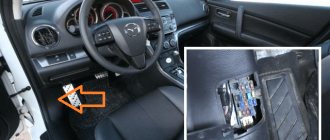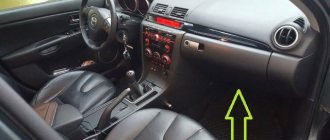Nissan X-Trail T31 fuses are responsible for the safe operation of electrical appliances. They break the electrical circuit in case of excessive current loads and short circuits, which prevents the ignition of wires and equipment.
The X-Trail T31 fuse block and relay element diagram is mounted under the hood and in the cabin . Next, we will consider in detail their area of responsibilities.
Fuse box Nissan x-trail T31
Fuse blocks under the hood of Nissan X-Trail T31
Blocks A and B
There are several mounting blocks . Next, let's look at where the X-Trail T31 fuse blocks are located and their protection zone. Blocks A and B are located under the air duct ; there are also fuses on the positive terminal of the X-Trail t31 battery. Accordingly, to gain access to blocks A and B, you will need to dismantle the air duct .
Materials detailing the maintenance and repair of the X-Trail T31 in the appropriate section.
Scheme and protected zone of elements of block A
To access block A, release the latch
. Fuse block A of the Nissan X-Trail T31 is closed with a plastic cover. To remove it, you will need to disengage the locking latch . the rated current value of the fuse links is indicated in brackets :
- Ef31 – heated front row of seats (20);
- Ef32 – electric cooling pump relay for turbocharger (20);
- Ef33 – signal and daytime running lights (10);
- Ef34 – generator, signal (10);
- Ef35 – multimedia complex (15);
- Ef36 – auxiliary heater (30);
- Ef37 – heated rear row of seats (20);
- Ef38 – CVT ECU (10);
- EfF – EUR (60);
- EfG – front optics washing complex (30);
- EfH, Efl – ESP, ABS (30, 50);
- EfJ – electric drive of the glass lift (50);
- EfK, EfM – power unit radiator cooling fan (40);
- EfL – ignition switch (40).
Block A fuse diagram
The diagram also provides for the use of the following relays :
- EM – signal;
- Eg2 – the second and third speeds of rotation of the cooling fan of the radiator of the power unit;
- EgZ – braking alerts;
- Eg4 – the first speed of rotation of the radiator cooling fan of the Nissan power unit;
- Eg5 – front optics washer complex;
- Eg6 - daytime running lights.
You will find the X-Trail T31 maintenance schedule with replacement intervals and consumable part numbers in this material.
Fuse box B X-Trail T31 under the hood
To access block B, we unclip the latch.
Access to the protective elements of mounting block B of the Nissan X-Trail T31 opens after disengaging the four plastic clamps . It uses the following relays :
- Er7 – front fog light;
- Er8 – low beam;
- Er9 – power unit ECU;
- Er10 – heated external mirrors and rear window;
- Er11 – Nissan starter;
- Er12, Er13, Er14 – radiator cooling fan, respectively for 3, 2 and 1 speed;
- Er15 – ignition systems.
Block B fuse diagram
The fuse diagram of this Nissan block is as follows:
- Ef41, Ef42, Ef47, Ef52, Ef53, Ef54 – not used;
- Ef43, Ef44 – right and left high beam (10A);
- Ef45 – size fuse (10A);
- Ef46 – interior lighting (10A);
- Ef48 – windshield wipers (20A);
- Ef49, Ef50 – left and right low beam headlight (10A);
- Ef51 – air conditioning compressor clutch (10A);
- Ef55, Ef56 – heating complex of external mirrors and rear window (15A);
- Ef57 – fuel pump fuse (15A);
- Ef58 – starter excitation winding, automatic transmission position sensor (10A);
- Ef59 – ABS (10A);
- Ef60 – reverse lamp (10A);
- Ef61 – power unit ECU (15A);
- Ef62 – power unit ECU, ignition coils (15A);
- Ef63 – oxygen sensor (20A);
- Ef64 – fuel injectors (15A);
- Ef65 – front fog lights (15A).
Fuse links on the battery positive terminal
Fuse diagram on the positive terminal of the battery
The following fuses are mounted on the positive terminal of the X-Trail T31 battery :
- EfA – generator and supply lines of protective devices EBfB, C (140A);
- EfB – power supply circuits for elements Ef35, 36, 37, 38, EfJ, K, L, M (100A);
- EfC – climate control, backlight (100A);
- EfD – relay part of the ignition complex, power lines F55, 56, 61, 62 (100A);
- EfE – power supply to protective elements Ef61, 62 (80A);
- EfN – control complex for glow plugs (60A).
Fuses and relays Nissan X-Trail T31
The crossover power circuits are protected by relays and fuses. The elements are installed in blocks that are located in the engine compartment and in the passenger compartment.
The diagrams of the Nissan X-Trail T31 2007, 2008, 2009, 2010, 2011, 2012, 2013, 2014, 2015, 2016, 2022 model years are considered.
In the engine compartment
On the car, the protective elements are installed in the main A and additional B mounting blocks located in the engine compartment under the air intake.
Assignment of fuses in block A in the engine compartment
| № | Protected circuit | Current, A |
| 1 | No | — |
| 2 | — | |
| 3 | High beam (right) | 10 |
| 4 | High beam (left) | 10 |
| 5 | parking lights | 10 |
| 6 | Backlight | 10 |
| 7 | — | |
| 8 | Windshield wiper | 20 |
| 9 | Low beam (right) | 10 |
| 10 | Low beam (left) | 10 |
| 11 | A/C compressor clutch | 10 |
| 12 | No | — |
| 13 | Spare | 30 |
| 14 | No | — |
| 15 | Electrically heated side mirrors and tailgate glass | 15 |
| 16 | 15 | |
| 17 | Gasoline pump | 15 |
| 18 | Automatic transmission operating mode sensor, starter coil relay | 10 |
| 19 | ABS control unit | 10 |
| 20 | Reversing lights | 10 |
| 21 | Engine ECU | 15 |
| 22 | Engine ECU, ignition coil control system | 15 |
| 23 | Diagnostic oxygen concentration sensor | 20 |
| 24 | Injector control system | 15 |
| 25 | Fog lights | 15 |
| Relay | ||
| R1 | Fog lights | |
| R2 | low beam | |
| R3 | Engine ECU relay | |
| R4 | heated side mirrors and tailgate glass | |
| R5 | starter | |
| R6 | electric cooling fan | |
| R7 | ||
| R8 | ||
| R9 | ignition |
Assignment of fuses in block B in the engine compartment
| № | Protected circuit | Current, A |
| 1 | CVT ECU | 10 |
| 2 | Heated rear seats | 20 |
| 3 | Auxiliary heater (diesel engine) | 30 |
| 4 | system | 15 |
| 5 | Horn, generator | 10 |
| 6 | Daylight, sound signal | 10 |
| 7 | Electric turbocharger cooling pump (diesel engine) | 20 |
| 8 | Heated front seats | 20 |
| P1 | ABS (ESP) system | 50 |
| P2 | 30 | |
| P3 | Headlight washers | 30 |
| P4 | Electric power steering | 60 |
| P5 | Engine cooling fan | 40 |
| P6 | Ignition switch (lock) | 40 |
| P7 | Engine cooling fan | 40 |
| P8 | Window control unit | 50 |
| Relay | ||
| R1 | Outdoor lighting relay | |
| R2 | headlight washer | |
| R3 | Low speed cooling fan relay | |
| R4 | brake light activation, additional heater (diesel engine) | |
| R5 | sound signal | |
| R6 | Engine Cooling Fan High Speed Relay |
Also in the additional fuse box attached to the positive terminal of the battery.
In the cabin
The mounting block is located in the cabin under the cover in the opening of the lower trim of the instrument panel.
Purpose of fuses in the cabin of the X Trail T31
| № | Protected circuit | Current, A |
| 1 | Power mirrors, audio system | 10 |
| 2 | Sockets | 15 |
| 3 | cigarette lighter fuse | 10 |
| 4 | — | |
| 5 | Air conditioning fan | 15 |
| 6 | 15 | |
| 7 | Keyless Entry System | 10 |
| 8 | Upper auxiliary lights | 15 |
| 9 | All-wheel drive control unit | 10 |
| 10 | Brake lights | 10 |
| 11 | Interior lighting | 10 |
| 12 | Instrument cluster | 10 |
| 13 | Electrical control unit | 10 |
| 14 | system | 10 |
| 15 | Electrically heated side mirrors | 10 |
| 16 | system | 20 |
| 17 | Windshield washer pump | 10 |
| 18 | Instrument cluster | 10 |
| 19 | Airbags | 10 |
| 20 | Diagnostic connector, engine ECU, electric headlight level control | 10 |
| Relay | ||
| R1 | Relay for turning on the upper additional headlights | |
| R2 | Optional equipment | |
| R3 | Turning on the air conditioning fan | |
| R4 | Turning on the heated seats | |
| R5 | Turning on the overhead auxiliary headlights |
Interior fuse box Nissan X-Trail t31
Location of the cabin fuse box
The X-Trail T31 cabin mounting block is installed on the left side of the center console , where the instrument panel is located. The circuit includes a relay :
- R1 – auxiliary equipment;
- R2 – electric climate control fan;
- R3, R5 – additional headlights;
- R4 – seat heating complex.
Also in the X-Treil T31 block the following fuses , most of which are equipped with a fuse link with a rated current of 10A (F1, F2, F3, F4, F6, F7, F8, F9, F10, F11, F12, F14, F18, F20 ):
- F1 – Nissan power unit ECU, connector for diagnostics, electric light control in headlights with automated operation;
- F2 – airbags;
- F3, F9 – instrument panel;
- F4 – glass washing complex;
- F5, F7 – multimedia system (20A);
- F6 – heating system for external mirrors;
- F8 – electrical devices, electrical equipment control system;
- F10 – interior lighting;
- F11 – warning that the brake light is on;
- F12 – all-wheel drive software package;
- F13 – auxiliary optics (15A);
- F14 – opening doors without using a key;
- F15, F16 – electric climate control fan (15A);
- F17 – not used;
- F18 – cigarette lighter fuse;
- F19 – sockets (15A);
- F20 – multimedia complex, electric mirror drive.
Fuse box diagram in the cabin
Typical symptoms of faulty fuses
- The equipment is inactive when starting, applying voltage;
- An indicator on the instrument panel indicates a breakdown of equipment in the engine compartment;
- The mounting block is hot to the touch, with a clearly elevated operating temperature;
- At the location of the mounting block, you can hear the smell of melted, burnt, plastic.
Correct procedure for replacing fuses
Before replacing a failed X-Trail T31 fuse, you should make sure that it is faulty.
To do this you will need to do the following:
- Identify the X-Trail T31 mounting block, from which electrical equipment that has failed to function consumes electricity.
- Using the list of non-working devices, determine the faulty protective element.
- Remove the fuse from its socket and inspect it .
- The presence of obvious damage indicates a malfunction of the element.
Replacing an element with a damaged fuse link:
- The cause of the malfunction is and eliminated.
- Further standard size is selected fuse (mini, medium or large), according to the required rated current.
- The old one is removed and protective element is inserted
- The functioning of electrical appliances is checked.
Common causes of fuse failure
- Failure to comply with the manufacturer's recommendations regarding the timing of technical inspection;
- Savings on the purchase of original spare parts;
- Violation of installation and replacement technology;
- Damage to the integrity of protection modules;
- Short circuit in the circuit;
- Wear of electrical cable insulation;
- Oxidation of contacts;
- Formation of condensation, moisture ingress;
- Loose contacts of terminals, blocks with wires.
Removal and replacement process
In this article, we have definitely determined that these elements are designed to burn out, which requires subsequent replacement. Sometimes in Nissan X Trail T31 and T30 cars you need to replace one element, and sometimes the whole unit. In the Nissan Trail T30 and T31, the general principle of replacing protective components is the same, however, under the hood and inside the car, replacement occurs in different ways.
In order to start replacing, you first need to determine whether the part really burned out. Under no circumstances pull out the part or examine it in the light, as many car owners do. This method is not reliable. In order to detect a damaged part, you need to turn on all non-working circuits (for example, a stove, tape recorder, etc.), take a probe and start checking the voltage, do this first on one side, then on the other, respectively. If there is voltage from one terminal and not from the other, then the part is damaged. Such a check in a Nissan Trail T31 car takes about 1 minute.
The Nissan X Trail T31 heater does not work ~ AUTOTEXNIKA.RU
page » Heater Nissan X Trail T31 does not work
11.03.2019
When designing the T30, the Land of the Rising Sun thought little about the internal heating system. The engine must warm up for a long time to blow warm air out of the deflectors. And at low temperatures, standing in one place, the engine does not heat up at all. If the furnace was working reasonably well and then suddenly doesn't do its job at all, the entire engine cooling system should be checked. No matter how poorly designed your car's heating system is, it will keep you from freezing. In this case, even when heating for a long time, no heat even occurs, so there is no possibility of malfunction.
To know about the difficulties associated with the stove, it is necessary to make a detailed diagnosis and then decide on the next steps (repair or upgrade).
- Immediately check the antifreeze level, it is limited approximately between the maximum and like in a movie theater in the expansion tank.
- Then check the expansion tank cap. It is possible to do this by passing air from the lungs through it, it must hold pressure, the air must not pass through it freely.
- Thermostat malfunction when the engine takes a long time to heat up to operating temperature or the engine does not heat up at all. Another sign would be the fact that when the car is moving, the engine does not return to operating temperature, but this does not happen when it stops. Checking the thermostat is not an option, but after 5-7 minutes of engine operation. The block to the thermostat and the pipe at the end should be checked. The pipe should remain cold without adjusting the torque quality until the antifreeze temperature reaches 80°C.
- Low water pressure or possibly due to pump failure. The impeller is worn out and does not even create enough pressure for good water circulation in the heater core. In the event of such a breakdown (in the early stages), the stove stops heating the air when the engine is idling; heat enters the cabin only when the engine speed rises above average.
- A clogged radiator is probably a necessary condition for lousy indoor heating. Moreover, it can be clogged both inside and outside. Inside, with small particles from the cooling system, and outside with dust from outside.
- How to Check the Oil Level in an Al4 Automatic Transmission
- New Defender Introduced by Commander Convertible
- Chevrolet Lacetti ABS light is on
After diagnostics and breakdowns, the stove is repaired. It is carried out both by employees and by contacting intelligence services.
Replacing the Nissan X-Trail fan
- If there is not enough coolant in the tank, you will need to find the leak and clear the drain. If you don't see a leak, there is a good chance that the gasket between the cylinder block and the cylinder head is damaged. This malfunction will be accompanied by an increase in the level of oil and steam from the exhaust pipe. In case of such a breakdown, you need to consult a specialist or change the gasket yourself. After eliminating the leaks, it is necessary to release the “plug” from the cooling system.
- If a faulty valve is found in the expansion tank cap, it must be replaced.
- To replace the thermostat, drain all the coolant, unscrew the clamp from the pipe and remove the pipe itself. Then unscrew the thermostat cap, remove the valve itself and replace it with a new one. After this, reassemble everything in reverse order, fill in coolant and remove the “air lock”.
- Repairing a faulty pump is only possible when replacing the last pump.
To update the metering (software), you can "install" an additional electric pump to power the heater, which will not only allow hot water to flow through the furnace radiator, which will provide the best interior heating even at idle. - A clogged radiator can be cleaned with a special chemical composition, and it can be replaced with a new one. This will ensure better heat loss from the radiator and, accordingly, better heating of the interior.
These Nissan X-Trail 31 heat and repair tips will help you diagnose and then repair it yourself. In this case, you are driving the car in very cool weather conditions and the above diagnostics have shown that all components and components are working properly, then covering the engine radiator with a thick material will help. Also, of course, cover the top of the engine with a similar material (you must make sure that the material does not form oil stains, this leads to a fire).
Or installing an additional autonomous heater. This is a common rumor. the most expensive option, but you will be satisfied with the result. The car will be warm in any weather, and there will be no problems when starting.
- Connecting the Tachometer Gazelle 406 Injector
- What Color Should Engine Oil Be?
- Replacing Thermostat Lexus Рх 300
- Where is the Idle Speed Sensor on Nissan?
Description of the replacement process
First you need to sit comfortably at the repair site, and then:
- Open the cover of the relay and fuse block.
- Use the table above to find the part you need to check or replace.
- Remove the damaged part and install a new one. At the same time, check the contacts and clean them if necessary.
But first you need to make sure there is a breakdown.
To detect damage, you will need to do the following:
- turn on all circuits that do not work (heating device, multimedia or other system);
- insert the part being tested, swapping the pins;
- check the voltage in the circuit.
It is necessary to check the voltage on both sides of the conductor. If voltage is not supplied to the other end of the fuse device, then it is broken. Carrying out such a check is not difficult, and it will only take about a minute. After it, you can be 100% confident in the performance of the fusible part.
Thus, the process of replacing electrical system protection parts on the Nissan X-Trail T31 is not difficult. It just takes a little skill. The main thing is to always have a correspondence table nearby so as not to make a mistake. If it is rubbed onto the assembly cover, then it is better to print it out from the article.
Description of the replacement process
First you need to sit comfortably at the repair site, and then:
- Open the cover of the relay and fuse block.
- Use the table above to find the part you need to check or replace.
- Remove the damaged part and install a new one. At the same time, check the contacts and clean them if necessary.
But first you need to make sure there is a breakdown.
Attention! There is no need to check the fuse with a light. To detect damage, you will need to do the following:
To detect damage, you will need to do the following:
- turn on all circuits that do not work (heating device, multimedia or other system);
- insert the part being tested, swapping the pins;
- check the voltage in the circuit.
It is necessary to check the voltage on both sides of the conductor. If voltage is not supplied to the other end of the fuse device, then it is broken. Carrying out such a check is not difficult, and it will only take about a minute. After it, you can be 100% confident in the performance of the fusible part.
Thus, the process of replacing electrical system protection parts on the Nissan X-Trail T31 is not difficult. It just takes a little skill. The main thing is to always have a correspondence table nearby so as not to make a mistake. If it is rubbed onto the assembly cover, then it is better to print it out from the article.
Placing Blocks
As in other cars in the Nissan X-Trail T31, the fuse and relay blocks are located:
- in the cabin;
- under the hood.
A special feature of this machine is that there are 2 units located in the engine compartment at once. More on this below, where information is provided on the diagram, purpose of parts and the process of replacing fusible elements of the X-Trail T31. This information will be useful during repair work, because no one knows where the problem will occur. It would be good if it was a populated area where you could find help. And if a breakdown happens on the highway or in the forest, then you will have to solve the problem yourself, relying on the information from the article.











